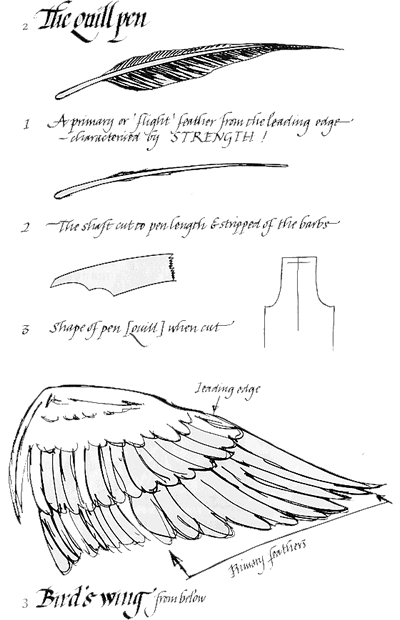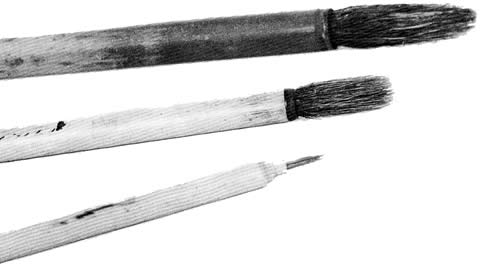The Art of Written Forms
Writing Instruments and Surfaces - From the point of view of their effect on form
Writing Instruments
The Pen
Used mainly by Western, but also Islamic calligraphers, the pen was the preferred instrument for writing with and ranged from those made of reed and feathers and to the later metal types. Its history dates back to ancient Egyptian times when a type of brush-pen replaced the pointed and more flexible stylus.
The brush-pen was cut to a length of about 15-20 cm from the thin stem to narrow rush plant. The scribe would then hammer and chew one end so as to fray the plantsfibres and allow a certain amount of ink to be retained whilst writing. These pens wrote well on papyrus, but not so well on parchment and was replaced in the 6th Century AD with the introduction of the Quill pen.

The best quill pens are those taken from the flight feathers (which are the leading feathers on a birds wing) from Swans, Turkeys or Geese. These feathers are stronger and tend to be easier to cut into broad edged pens. Of the flight feathers, the first two or three from the leading edge of the wing are of most use to the scribe. Quills can be made from feathers taken from other birds such as ravens or crows, but these tend to cause discomfort for the scribe. For the right-handed scribe, feathers are taken from the left wing of the bird as they curve more easily to the hand.
Before any feathers can be used as writing instruments, some preparation is required to make them of any real use to the calligrapher.
When the feathers have been selected, they must be left to mature. This takes about 18 months or so; a long process which some calligraphers avoid by heating the feathers in hot sand so that they become firm and brittle rather than soft and and flexible.
(Lancaster, 1986)
The shaft of the feather is then cut to a suitable length for writing with, using a penknife, and then striped of its feathered parts (the 'barbs'). Finally, and perhaps the most important part is shaping the quills nib so that it is sharp and can produce the desired style of lettering.
For larger script writing (lettering over half an inch in height) a reed or bamboo pen (to Islamic calligraphers known as the 'qalum') is preferred. Cut from dried reed, 10cm long and 1 cm wide, the upper edge was rounded so as to not hurt the fingers of the scribe. Islamic scribes cut their reeds in March, covered them with fermenting manure for six months so as to dry the pith and harden the reed and in doing so making the nib more durable.
Although both the quill and the reed pens were very durable - often lasting many years, their nibs still needed cutting across (quite often as much as sixty times a day) and reshaping. It is therefore no surprise then, that with the increase of business, administration and schooling in 18th Century Western Europe, and the introduction of metal nibs, fountain pens and later the ballpoint pen, that these earlier pens found less and less favour becoming the reserve of the hobbyist and professional calligrapher.
The Brush
Chinese calligraphy is an art with an illustrious tradition as old as the culture itself. It can be regarded as a precursor and companion of the art of painting in China and it's
the brush that has been the important influence in the development of both painting and calligraphy.
(Long, 1987)
The Han period (206BC - 220 AD) was a time at which calligraphy gained great importance and also many improvements. These occurred mainly due to the availability of materials such as silk and later paper on which the the brush could be used to its fullest effect.
The traditional Chinese brush is about, according to ancient measurements 23-30cm long, and consists of holder, hair part and sheath. According to the type of animal hair used, brushes are categorised into two types, hard-fur brushes ('jian hoa') and soft-fur brushes ('rou hao'). Hard-fur brushes are made from weasel hair, are more elastic, and can produce lines almost as fine as a steel pen. Soft-fur brushes rely mostly on goat hair, has weaker spring, is harder to control, but better able to produce a variation of stroke: rabbit and deer hair may also have been added.
(Gaur, 1994)
The adaptability of the Chinese brush is very much a result of the way it is held. It is not held close to the bristles, but rather in the middle or at the top of the handle depending on the stoke being executed at the time. The hand is unsupported and is able to move freely.
In ancient times the grip was not exactly the same as it is now. One book describes the moving of the ring finger and little finger from the front to the underside of the brush as being as decisive a movement as the adoption of the stirrup in warfare. A totally different method was invented which gave incredibly more control to the movement of the brush and therefore produced a whole new range of painting.
(Long, 1987)
Examples of heavy and light pressure

The brush can be held in either the upright position or obliquely (however the grip remains the same) and this has repercussions as to the lettering produced: upright produces a neat, clear-cut line with a hard edge on both sides, whilst the oblique method produces a wider stoke. Further variations to the lines produced can be attained by the amount of pressure applied - heavier the pressure, the wider the stroke.

A Selection of brushes of varying widths and stiffness
Writing Surfaces
Silk
Before the invention of paper, writing was done on fabric- especially silks giving rise to the custom - still in existence - of writing maxims and sayings on large panels of silk (red in most cases) and hanging them inside houses. At funerals suspended panels are carried beside the coffins of the dead, describing their characters in glowing term. (Long, 1987) However silk was costly and so when a cheaper substitute was found, it was greatly welcomed.
Paper
Paper gets its name from papyrus, a reed that the ancient Egyptians used as a writing material. They cut the papyrus into thin strips and then pressed crisscrossed layers of strips into sheets.
Paper was invented by Cai Lun (61-121 AD) in 105 AD according to the Chinese historian Fan Yie (397-445 AD). At first the Chinese used the hemp plant or the inner bark of the mulberry tree for fibre. Later, they found that good paper making fibres could be obtained by pounding rags, rope or old fishing nets into a pulp. However, the paper produced was far too coarse for writing on.
The Chinese art of paper making spread to other parts of the world after several Chinese paper makers were captured by Arabs in what is now Western Turkestan. The Arabs urged these paper makers to continue their art and teach it to the Moors in the city of Samarquad. Paper making then spread to Europe as a result of the Crusades and the Moorish conquest of northern Africa and Spain.
The absorbency is an essential quality of the paper. Individual papers - rice-paper, mulberry or bamboo - react differently to brush stokes, and so the writing surface can have a determining effect on the style of of the painting.
The technique of the brush stroke is affected by whether the paper surface is rough, smooth, dull or glossy, more or less absorbent, so the techniques required may include a quicker brush stroke, a drier brush than usual, greater control of the ink, thicker brush work and a more all-over style.
(Long, 1987)
Parchment
Parchment is an animal skin that has been prepared as a surface for writing and is usually made from the skins of sheep, goats or calves. Parchment is very durable, and many examples have survived from about 1500 BC. Parchment is made by first washing it then placing it in lime to remove hair and fat. It is then stretched on a frame and thinned with knives and scrapers. Finally it is rubbed with chalk and pumice in order to create a smooth white writing surface. Some of these stages have to be repeated many times. Paper largely replaced parchment around 1400 AD around the time of the development of printing.
Conclusion
In conclusion, from reading round this subject in order to write this paper, many factors influence the form of lettering and calligraphy. Primarily though it is the calligrapher and the fashion and culture of their period of work that has the greatest effect on the overall form. However, in regards to writing instruments, the developments from brush-pens to reed and quill pens allowed the calligrapher more freedom (and more time) as they could vary their work according to the way in which the nib was cut, the angle at which the pen was held etc. In fact later developments (metal nibs, fountain pens) perhaps narrowed the calligraphers creative freedom but by this time, it was more important to just get text written down with the rapid increase in trade, administration and schooling. The brush is another instrument that gives the calligrapher the opportunity to express himself, especially since not just the hand, but the arm - the whole body becomes involved.
In respect to the writing surfaces, developments were somewhat dictated by the need to be un-obstructed by the surface so as it becomes almost invisible. The smoother and easier to use it becomes (as well as its availability, time to prepare and its cost) the better.
Bibliography
- Gaur, A (1994) - A History of Calligraphy
- British Library
- Lai, T. C. (1973) - Chinese Calligraphy - Introduction by Jiu-fing L. Chang
- University of Washington Press
- Lancaster, J (1986) - Calligraphy Techniques
- B T Batsford
- Long, J (1987) - The Art of Chinese Calligraphy
- Blandford Press
The Art of Written Forms
Four resulting essays from my second year degree elective programme.
